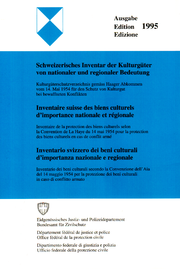
Swiss Inventory of Cultural Property of National and Regional Significance
Encyclopedia
The Swiss Inventory of Cultural Property of National and Regional Significance is a register of some 8,300 items of cultural property
in Switzerland
. It was established according to article 5 of the second protocol to the Hague Convention for the Protection of Cultural Property in the Event of Armed Conflict
, which provides for the establishment of national registers of cultural property.
, aesthetics
, art
, typology
, ethnography
, social studies and in other scientific disciplines, as well as on their rarity value. Items of purely local significance are not included; these may be registered separately by the cantonal authorities.
 The register is prepared by the Federal Office of Civil Protection in cooperation with the cantonal authorities and formally issued by the Federal Council. It was first published in 1988 and re-issued in updated form in 1995 and 2009. The 2009 revision covers only A-class objects, with the B-class objects set to be reviewed and updated at a later time. Until then, the lists of B-class objects published by the Office include the B-class objects of the 1995 inventory, the proposals for new or changed B-class objects submitted by the cantonal authorities, and the former A-class objects not retained as nationally significant in the 2009 review.
The register is prepared by the Federal Office of Civil Protection in cooperation with the cantonal authorities and formally issued by the Federal Council. It was first published in 1988 and re-issued in updated form in 1995 and 2009. The 2009 revision covers only A-class objects, with the B-class objects set to be reviewed and updated at a later time. Until then, the lists of B-class objects published by the Office include the B-class objects of the 1995 inventory, the proposals for new or changed B-class objects submitted by the cantonal authorities, and the former A-class objects not retained as nationally significant in the 2009 review.
The Federal Office of Civil Protection has made the 2009 register of A-class objects (current as of 1 April 2010) available on the Internet as a geographic information system
and as a set of PDF documents. A printed catalogue (publication no. 408.980) was published in 2010.
Cultural property
Cultural property are the physical constituents of the cultural heritage of a group or society.-Definition:Article 1 of the Hague Convention for the Protection of Cultural Property in the Event of Armed Conflict of 1954 defines cultural property as follows:...
in Switzerland
Switzerland
Switzerland name of one of the Swiss cantons. ; ; ; or ), in its full name the Swiss Confederation , is a federal republic consisting of 26 cantons, with Bern as the seat of the federal authorities. The country is situated in Western Europe,Or Central Europe depending on the definition....
. It was established according to article 5 of the second protocol to the Hague Convention for the Protection of Cultural Property in the Event of Armed Conflict
Hague Convention for the Protection of Cultural Property in the Event of Armed Conflict
The Hague Convention for the Protection of Cultural Property in the Event of Armed Conflict is an international treaty that requires its signatories to protect cultural property in war. It was signed at The Hague, Netherlands, on May 14, 1954, and entered into force August 7, 1956...
, which provides for the establishment of national registers of cultural property.
Scope
The register contains mostly immobile items of cultural property such as old towns, quarters, squares, villages, sacral buildings, houses, castles, bridges, monuments, archaeological sites and collections. Its entries are classified in two groups: those of national significance (class A – some 1,800 entries) and those of regional significance (class B). The selection is based on the significance of the items in the domains of historyHistory
History is the discovery, collection, organization, and presentation of information about past events. History can also mean the period of time after writing was invented. Scholars who write about history are called historians...
, aesthetics
Aesthetics
Aesthetics is a branch of philosophy dealing with the nature of beauty, art, and taste, and with the creation and appreciation of beauty. It is more scientifically defined as the study of sensory or sensori-emotional values, sometimes called judgments of sentiment and taste...
, art
Art
Art is the product or process of deliberately arranging items in a way that influences and affects one or more of the senses, emotions, and intellect....
, typology
Typology
Typology is the study of types. More specifically, it may refer to:*Typology , division of culture by races*Typology , classification of things according to their characteristics...
, ethnography
Ethnography
Ethnography is a qualitative method aimed to learn and understand cultural phenomena which reflect the knowledge and system of meanings guiding the life of a cultural group...
, social studies and in other scientific disciplines, as well as on their rarity value. Items of purely local significance are not included; these may be registered separately by the cantonal authorities.
Publication history

The Federal Office of Civil Protection has made the 2009 register of A-class objects (current as of 1 April 2010) available on the Internet as a geographic information system
Geographic Information System
A geographic information system, geographical information science, or geospatial information studies is a system designed to capture, store, manipulate, analyze, manage, and present all types of geographically referenced data...
and as a set of PDF documents. A printed catalogue (publication no. 408.980) was published in 2010.
List
- See also: Category of articles covering A-class entries
External links
- Swiss Inventory of Cultural Property of National and Regional Significance, 2009 edition:
- PDF documents: Class A objects
- PDF documents: Class B objects
- Geographic information system

